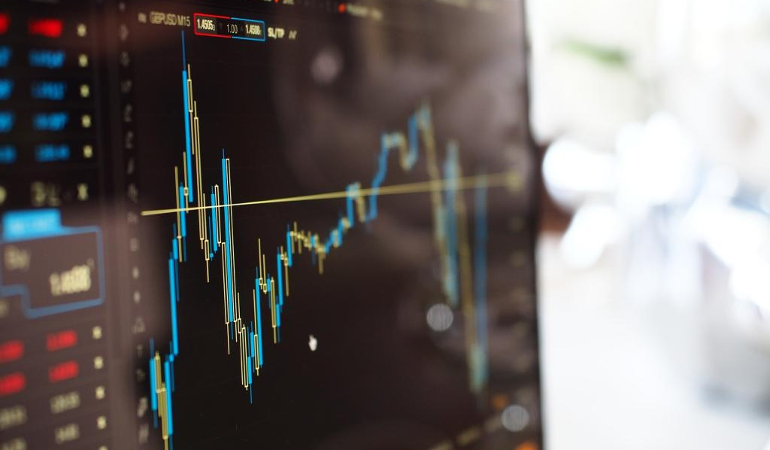Humans remain key players in stock markets, but the use of AI for trading is increasingly impacting the industry. The share of algorithmic (algo) trading — where AI-based computer algorithms automatically execute trades — is continuously growing.
This means that the era of relying solely on personal analysis and gut feelings for investment decisions is coming to an end. Who and what influences the market at any given moment? How do people feel about a new product from a company in the Dow Jones Industrial Average? AI trading solutions that perform accurate financial analysis and predict market movements can answer these questions and help you earn – or save – millions of dollars.
Capital markets themselves are derivative of the biases and preferences people bring to decision-making. Everybody has the information. But are people reacting to it rationally?
At Intellias, we bring years of experience in capital markets consulting. In this article, we share our insights on using AI for stock trading, explain how it works, and showcase real-life use cases.
What is AI trading?
AI trading refers to using AI technologies like machine learning (ML), deep learning (DL), and natural language processing (NLP) to sift through vast amounts of market data, make financial predictions, and automatically execute trades.
While hedge funds and investment companies have been using computer algorithms for years, traditional trading software is limited in making financial predictions. That’s because this software is often based on static models that do not change unless manually updated.
In contrast, AI-powered solutions use ML and DL algorithms that can learn from historical and real-time data. Unlike traditional trading systems, AI systems develop their own rules, connections, and patterns while analyzing data. What’s more, they account for market volatilities, adapt to new information, and improve predictive accuracy over time.
Overall, the volume and detail of information processed by AI tools far exceeds what humans or traditional trading systems can handle. How do stock intelligence solutions achieve this? Let’s explore further in the next section.
How AI in stock trading works
The process of using AI to trade stocks and complete related tasks is both fascinating and intricate. Imagine a high-tech mastermind that’s always working, meticulously analyzing every market movement and adapting to new data in real time. Below, we explain how an AI-driven trading system works, transforming raw data into actionable insights.
Data collection
The first step in AI trading is collecting data. AI trading software gathers a wide array of market data, including historical and real-time prices, trading volumes, and order book data. It also scours financial news, company reports, and economic indicators and gathers alternative data.
Alternative data refers to information collected from non-traditional sources, such as social media sentiment and web traffic indicators. It can provide unique insights into market trends and enhance the accuracy of predictions.
Feature extraction
This stage involves several key steps. The first is data cleansing (to remove noise and irrelevant information), followed by data normalization and integration. Next, data scientists, with the help of AI-powered software, identify which aspects of the data (known as features or variables) are most relevant for predicting market movements.
Model training
Once data is preprocessed and features are extracted, model training begins — a crucial stage where the magic of using AI for stock trading come to life. Based on the trading strategy, data scientists and software engineers, in collaboration with stock trading experts, select appropriate machine learning algorithms.
These algorithms are then trained on historical data to identify patterns and relationships. Through this training, the models learn to predict future price movements and spot profitable trading opportunities. To assess the effectiveness and reliability of trained models, they are backtested on historical data.
Real-life trading with AI
By using trained models, AI-powered systems analyze real-time data to generate buy or sell signals for stock traders. The systems can also execute trades automatically based on these signals, often within milliseconds, capitalizing on the slightest price movements. To manage risks and lock in profits, AI-driven trading platforms contain predefined stop-loss and take-profit levels.
Continuous learning
The essential benefit of artificial intelligence in trading is its ability to learn and improve over time. AI-based systems update their models as they process more data and adapt to changing market conditions. Essentially, these systems monitor their own performance in real time and make adjustments to improve their predictive accuracy and trading outcomes.
How AI is reshaping the investment landscape

Using AI trading software solutions in financial markets enables investment companies, brokers, and traders to leverage advanced data analytics. In turn, this lets them:
- analyze exposure gaps, asset classes, volatility, and trading costs
- find the fastest ways to execute trades and make bets
- look for investment opportunities
- identify market patterns
- evaluate trading strategies
- automate work processes
How does this impact the investment landscape? The major change is the emergence of various AI use cases that are transforming how trading works, including:
- Algorithmic trading, which means using AI trading algorithms to trade stocks automatically based on certain criteria
- High-frequency trading (HFT), which allows for executing a large number of orders in fractions of a second
- Robo-advisors that assist investors in managing their portfolios by tailoring recommendations based on risk tolerance, financial goals, and the investment horizon
- Predictive analytics, which leverages AI to forecast future market conditions or price movements
New capabilities introduced by AI, such as real-time data analysis, adaptive learning, and nuanced pattern detection, have also greatly enhanced traditional trading strategies, including quantitative trading.
Technological innovations behind AI-powered trading

When it comes to AI in trading, we’re talking about a suite of cutting-edge technologies. As they evolve, AI-powered systems deliver more accurate predictions, react faster to market shifts, and gain deeper insights into underlying trends.
Big data analytics
Big data analytics involves processing and analyzing enormous volumes of data from diverse sources. That’s why the most important thing that AI trading systems need to work efficiently is information — millions of images, pages, cases, graphs, examples, etc. that are required for real-time analysis.
Machine learning
There are a lot of machine learning applications in finance, and using ML algorithms for AI trading is one of them. These algorithms process and analyze massive amounts of data to identify patterns and trends.
To build models that predict price movements, optimize trading strategies, and effectively deal with market volatility, engineers use various ML techniques, including:
- Supervised learning: training the system with labeled data to make predictions based on known outcomes
- Unsupervised learning: allowing the system to find patterns and relationships in unlabeled data without predefined outcomes
- Reinforcement learning: enabling the system to learn from trial and error, improving its performance based on feedback
Deep learning
The investment industry is an ideal fit for deep learning, as it offers a wealth of data for analysis. Deep learning models, which mimic the structure of the human brain, can identify patterns in large datasets, uncovering hidden relationships that traditional models might miss.
Here are some use cases of deep learning in trading:
- Portfolio management. Neural networks can effectively deal with development and risk strategies, as well as assist in picking stocks, compiling portfolios, and predicting long-term price movements.
- Social media analysis. Deep learning algorithms can identify key market influencers, monitor trends, track people’s reactions to events and products, provide demographic insights, and more. This helps gauge market sentiment and predict potential impacts on stock prices.
- News and event sentiment analysis. By browsing thousands of news events, press releases, reports, customer reviews, regulatory announcements, and economic and political headlines, neural networks can assess the sentiment — positive, negative, or neutral — towards various events. Using sentiment analysis, AI can serve as a hype detector and determine when markets are overreacting, potentially predicting corrections.
- Market time series. Neural networks can look for patterns by inspecting sequences of data points collected or recorded at consistent time intervals. This can help predict price movements, trading volumes, or other financial metrics, as well as detect anomalies such as unexpected spikes, drops, trend changes, and level shifts.
Natural language processing
Thanks to natural language processing (NLP), sophisticated AI-based financial software can understand and interpret human language. Specifically, NLP technology is used to analyze news articles, social media posts, earnings reports, and other text-based sources, extracting sentiments and key insights. This application of AI in trading helps traders better understand market sentiment and anticipate potential impacts on asset prices.
Cloud computing
Cloud computing is a critical foundation for AI in the stock market, as it provides the scalability and flexibility needed for AI-powered trading systems. Software engineers use cloud infrastructure to allow for the proper operation of artificial intelligence in trading platforms, as well as to ensure efficient processing and analysis of large datasets.
Examples of innovative AI-based tools for financial analysis and investment predictions

Several prominent hedge funds rely on AI stock trading software, including Renaissance Technologies, Man Group, Aidyia, Binatix, Sentient Technologies, and Bridgewater Associates. If you’re still skeptical about the effectiveness of AI in investing, here are some compelling cases:
- Chipotle. Based on foot traffic, Foursquare correctly forecasted the Chipotle restaurant chain’s drop in earnings before the company published its quarterly report.
- GoPro. The case with GoPro is even more interesting. While analysts were giving bullish forecasts, Quandl, a platform for financial, economic, and alternative data, analyzed GoPro’s email receipts and predicted a drop in share prices compared to the previous quarter. Quandl’s prediction proved accurate.
The market for AI-powered trading tools is growing, empowering traders with even more sophisticated capabilities. To explore how AI and trading work together, you can try out AI-powered tools like these:
- AlphaSense: This tool uses AI for stock market analysis, making it easy for users to search for key information from financial documents, earnings call transcripts, news, and other sources.
- Trade Ideas: Leveraging the power of artificial intelligence for trading, Trade Ideas identifies potential investment opportunities and provides users with actionable recommendations.
- Kavout: This platform offers AI-driven stock analysis and ranks stocks based on predicted future performance.
Overall, AI is valuable for analyzing market behavior, identifying trends, and making predictions. However, there are still many challenges associated with using AI for trading stocks. Let’s explore them.
Challenges of developing AI-based trading solutions

While AI has been transforming trading, developing effective AI-based solutions for stock markets comes with its own set of hurdles.
Data quality and volume
Data quality is a critical factor in developing effective AI trading solutions. If data is incomplete, noisy, or biased, predictions can be incorrect. But it’s not just about quality; the quantity of data needed to train AI models is extremely large. Managing and processing such large datasets can be rather complex.
Infrastructure
Real-time processing, a crucial aspect of AI trading, demands a robust and scalable infrastructure. This infrastructure must support high-speed data processing, the ability to handle intense data streams simultaneously, and low-latency communication. Additionally, it must be resilient and secure to protect sensitive financial data. Designing such an infrastructure presents another challenge in using artificial intelligence for trading.
Lack of interpretability
AI models can be incredibly complex and computationally intensive. This complexity leads to limited interpretability, as many AI models, such as neural networks, are seen as black boxes. This means it’s challenging to understand the underlying processes that lead to specific predictions, making it difficult for developers to test AI-driven trading systems.
Overcoming these challenges requires expertise in both AI and capital markets. That’s why it’s essential to work with a reliable tech partner like Intellias. We offer AI development services and have extensive experience in the trading industry. In the next section, we share practical recommendations for building AI-powered stock trading systems.
Best practices for AI trading platform development
Building a robust, scalable, and efficient AI-driven trading system requires expertise in both technology and financial markets. Here are some best practices to apply:
- Define clear requirements. This includes defining the target market, trading strategies, risk management protocols, compliance requirements, and more.
- Ensure access to quality data. It is essential to use a variety of data sources, such as historical market data, news, social media sentiment, and alternative data. You also need to implement robust data cleaning and preprocessing techniques to remove noise and biases from the data.
- Choose the right algorithms and train models. You should select algorithms that align with your specific trading strategies and objectives. Next, you need to develop and train models using comprehensive datasets. You also need to ensure that you regularly update these models with new data to maintain their accuracy and relevance.
- Test models within simulated environments. You should implement a robust validation and testing framework to evaluate the predictive accuracy and risk management capabilities of your AI models. It’s essential to conduct these tests in simulated environments before deploying them in live trading scenarios.
Yet, building an AI trading system is an ongoing process. That’s why it’s essential to monitor the performance of AI models and trading strategies. You also need to regularly review and update features, algorithms, and security measures to ensure that the platform remains effective.
Conclusion
AI trading brings unprecedented levels of precision, efficiency, and insights to stock market activities. Advanced AI algorithms enable traders to uncover hidden patterns and make more informed decisions. What’s more, as AI technology continues to advance, its role in trading will only become more significant. By embracing these innovations and addressing the associated challenges, traders and financial institutions can gain a substantial competitive edge.
Interested in exploring AI in stock trading? Contact us to discuss your ideas and how we can help!




